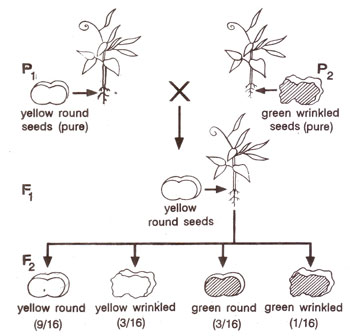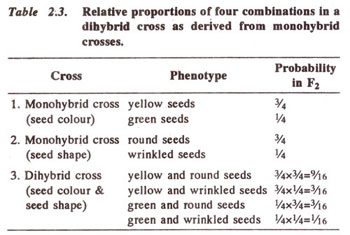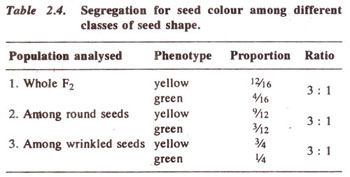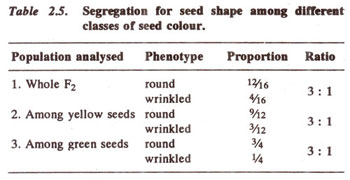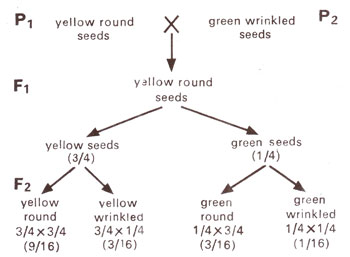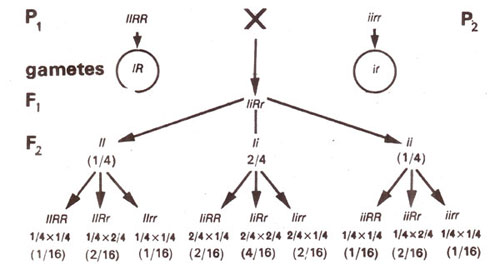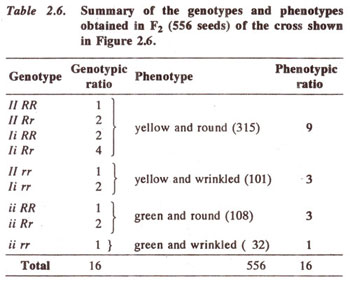Principle of independent assortment
As earlier pointed out, one of the secrets of Mendel's success was that he considered only one character at one time and, unlike earlier workers, did not study the individual as a whole. Such an approach soon enabled him to discover the principle of segregation. From this simplest situation, Mendel tried to analyse cases where two pairs of characters were simultaneously studied. He tried to find out whether one pair of characters is completely independent of another pair or else if there was any deviation. As we know, crosses where two pairs are involved are known as dihybrid crosses.
The classical example of a dihybrid cross is the use of two pairs of characters namely the seed shape and seed colour. The plants with yellow and round seeds (pure) were crossed with those having green and wrinkled seeds (pure). The F1seeds were yellow and round. When these F1seeds were grown into plants, F2 seeds were obtained which showed all the four possible combinations i.e. (i) yellow and round seeds, (ii) yellow and wrinkled seeds, (iii) green and round seeds, and (iv) green and wrinkled seeds. These four kinds of seeds were obtained in 9 : 3 : 3 : 1 ratio (Fig. 2.5).
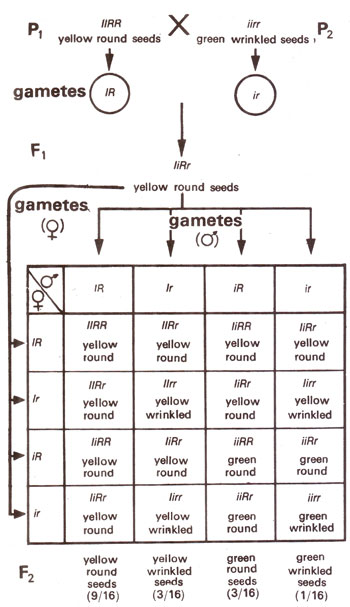 The above results would be expected if the two pairs of characters are believed to behave independent of each other. In the ratio 9 (yellow round) : 3 (yellow wrinkled) : 3 (green round) : 1 (green wrinkled), we can analyse them for single characters, separately as in Tables 2.3, 2.4 and 2.5. In this analysis it is obvious that, when one character is fixed, the other character exhibits a clear 3 : 1 ratio. Therefore, it can be concluded that the two characters under consideration are assorting (giving rise to different combinations) in an independent manner. This principle is known as 'principle of independent assortment'. The independent assortment holds good for two or more than two pairs of characters. The following discussion will be devoted to the theoretical derivation of dihybrid and trihybrid ratios on the basis of independent assortment.
The above results would be expected if the two pairs of characters are believed to behave independent of each other. In the ratio 9 (yellow round) : 3 (yellow wrinkled) : 3 (green round) : 1 (green wrinkled), we can analyse them for single characters, separately as in Tables 2.3, 2.4 and 2.5. In this analysis it is obvious that, when one character is fixed, the other character exhibits a clear 3 : 1 ratio. Therefore, it can be concluded that the two characters under consideration are assorting (giving rise to different combinations) in an independent manner. This principle is known as 'principle of independent assortment'. The independent assortment holds good for two or more than two pairs of characters. The following discussion will be devoted to the theoretical derivation of dihybrid and trihybrid ratios on the basis of independent assortment.
Dihybrid cross
A dihybrid cross is represented in Figure 2.6. This method of working out the F2 progeny using different kinds of male and female gametes is known as checkerboard. From the checkerboard the different phenotypes and the genotypes can be analysed. Table 2.6 shows a summary of the genotypic and phenotypic ratios in F2 progeny.The results of a dihybrid cross in F2 generation can also be obtained by the 'forked line method' shown in Figure 2.7 and Figure 2.8. The forked line method makes use of the consideration of single character at a time.

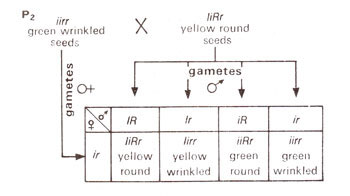
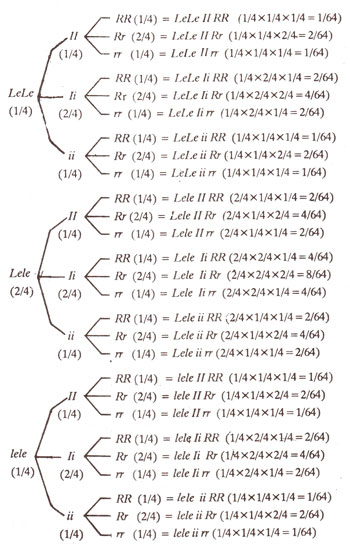 Dihybrid testcross
Dihybrid testcross
In the F2 progenies, only one of the four phenotypes i.e. green and wrinkled seeds will be homozygous for both characters. The other three phenotypes can be homozygous or heterozygous for one or both the characters. Testcross is used to test whether an individual is heterozygous or homozygous. For instance, if an individual is heterozygous for both characters (as in F1) and is crossed with double recessive, a phenotypic ratio of 1:1:1: 1 will be obtained. Diagrammatic representation in Figure 2.9 will explain it.
Trihybrid cross
The following three pairs of characters may be considered in a trihybrid cross, (i) tall plant vs. dwarf plant, (ii) yellow seed vs. green seed, (iii) round seed vs. wrinkled seed. The parents (LeLeIIRR and leleiirr) will give rise to the F1 hybrids (LeleliRr) which are heterozygous for three genes. Eight different types of gametes will be available in equal proportions both on the male side as well as on the female side (Fig. 2.10). A checkerboard technique will involve the drawing of 64 combinations. Therefore, for the study of three or more genes, checkerboard is rather difficult and forked line method is utilized. The diagrammatic representation in Figure 2.11 will show the results of a trihybrid cross.
The trihybrid testcross will involve crossing of a trihybrid (LeleIiRr) with triple recessive (leleiirr). The eight different phenotypes described in the previous section will be obtained in 1 : 1 : 1:1:1:1:1:1 ratio as shown in Figure 2.12.
A summary giving the genotypes, phenotypes and their ratios obtained in a trihybrid cross is presented in Table 2.7.

Fig. 2.6. A checkerboard showing 16 combinations obtained in a dihybrid cross involving characters for seed shape and seed colour.
A dihybrid cross is represented in Figure 2.6. This method of working out the F2 progeny using different kinds of male and female gametes is known as checkerboard. From the checkerboard the different phenotypes and the genotypes can be analysed. Table 2.6 shows a summary of the genotypic and phenotypic ratios in F2 progeny.The results of a dihybrid cross in F2 generation can also be obtained by the 'forked line method' shown in Figure 2.7 and Figure 2.8. The forked line method makes use of the consideration of single character at a time.

Fig. 2.6. A checkerboard showing 16 combinations obtained in a dihybrid cross involving characters for seed shape and seed colour.

Fig. 2.9. Diagrammatic representation of a dihybrid testcross involving seed shape and seed colour.

Fig. 2.11. The results of a trihybrid cross as derived by forked line method.
In the F2 progenies, only one of the four phenotypes i.e. green and wrinkled seeds will be homozygous for both characters. The other three phenotypes can be homozygous or heterozygous for one or both the characters. Testcross is used to test whether an individual is heterozygous or homozygous. For instance, if an individual is heterozygous for both characters (as in F1) and is crossed with double recessive, a phenotypic ratio of 1:1:1: 1 will be obtained. Diagrammatic representation in Figure 2.9 will explain it.
Trihybrid cross
The following three pairs of characters may be considered in a trihybrid cross, (i) tall plant vs. dwarf plant, (ii) yellow seed vs. green seed, (iii) round seed vs. wrinkled seed. The parents (LeLeIIRR and leleiirr) will give rise to the F1 hybrids (LeleliRr) which are heterozygous for three genes. Eight different types of gametes will be available in equal proportions both on the male side as well as on the female side (Fig. 2.10). A checkerboard technique will involve the drawing of 64 combinations. Therefore, for the study of three or more genes, checkerboard is rather difficult and forked line method is utilized. The diagrammatic representation in Figure 2.11 will show the results of a trihybrid cross.
The trihybrid testcross will involve crossing of a trihybrid (LeleIiRr) with triple recessive (leleiirr). The eight different phenotypes described in the previous section will be obtained in 1 : 1 : 1:1:1:1:1:1 ratio as shown in Figure 2.12.
A summary giving the genotypes, phenotypes and their ratios obtained in a trihybrid cross is presented in Table 2.7.
The trihybrid testcross will involve crossing of a trihybrid (LeleIiRr) with triple recessive (leleiirr). The eight different phenotypes described in the previous section will be obtained in 1 : 1 : 1:1:1:1:1:1 ratio as shown in Figure 2.12.
